Monooxygenase that mediates oxidation of dimethyl sulfide, the first step in dimethyl sulfide degradation pathway. Has much lower activity with diethyl sulfide and other short-chain alkyl methyl sulfides. •
MKKRIVLNAFDMTCVSHQSAGTWRHPSSQAARYNDLEYWTNMAMELERGCFDCLFIADVV
GVYDVYRGSAEMALRDADQVPVNDPFGAISAMAAVTEHVGFGVTAAITFEQPYLLARRLS
TLDHLTKGRVAWNVVSSYLNSAALNIGMDQQLAHDERYEMADEYMEVMYKLWEGSWEDDA
VKRDKKSGVFTDGSKVHPINHQGKYYKVPGFHICEPSPQRTPVIFQAGASGRGSKFAASN
AEGMFILTTSVEQARQITTDIRNQAEAAGRSRDSIKIFMLLTVITGDSDEAAEAKYQEYL
SYANPEGMLALYGGWTGIDFAKLDPDEPLQAMENDSLRTTLESLTHGENAKKWTVRDVIR
ERCIGGLGPVLVGGPQKVADELERWVDEGGVDGFNLAYAVTPGSVTDFIDYIVPELRKRG
RAQDSYKPGSLRRKLIGTNDGRVESTHPAAQYRDAYVGKESVADRTQPSPFANAKAPVAE
488

| PMID | Title & Author | Abstract | Year | |
| 0 | 30511672 | Crystal structure of the dimethylsulfide monooxygenase DmoA from Hyphomicrobium sulfonivorans. Hai Yan Cao , Peng Wang , Ming Peng , Xuan Shao , Xiu Lan Chen , Chun Yang Li | DmoA is a monooxygenase which uses dioxygen (O2) and reduced flavin mononucleotide (FMNH2) to catalyze the oxidation of dimethylsulfide (DMS). Although it has been characterized, the structure of DmoA remains unknown. Here, the crystal structure of DmoA was determined to a resolution of 2.28 Å and was compared with those of its homologues LadA and BdsA. The results showed that their overall structures are similar: they all share a conserved TIM-barrel fold which is composed of eight α-helices and eight β-strands. In addition, they all have five additional insertions. Detailed comparison showed that the structures have notable differences despite their high sequence similarity. The substrate-binding pocket of DmoA is smaller compared with those of LadA and BdsA. | 2018 |
| 1 | 21216999 | Purification and characterization of dimethylsulfide monooxygenase from Hyphomicrobium sulfonivorans. Rich Boden , Elena Borodina, Ann P Wood, Donovan P Kelly, J Colin Murrell, Hendrik Schäfer | Dimethylsulfide (DMS) is a volatile organosulfur compound which has been implicated in the biogeochemical cycling of sulfur and in climate control. Microbial degradation is a major sink for DMS. DMS metabolism in some bacteria involves its oxidation by a DMS monooxygenase in the first step of the degradation pathway; however, this enzyme has remained uncharacterized until now. We have purified a DMS monooxygenase from Hyphomicrobium sulfonivorans, which was previously isolated from garden soil. The enzyme is a member of the flavin-linked monooxygenases of the luciferase family and is most closely related to nitrilotriacetate monooxygenases. It consists of two subunits: DmoA, a 53-kDa FMNH₂-dependent monooxygenase, and DmoB, a 19-kDa NAD(P)H-dependent flavin oxidoreductase. Enzyme kinetics were investigated with a range of substrates and inhibitors. The enzyme had a K(m) of 17.2 (± 0.48) μM for DMS (k(cat) = 5.45 s⁻¹) and a V(max) of 1.25 (± 0.01) μmol NADH oxidized min⁻¹ (mg protein⁻¹). It was inhibited by umbelliferone, 8-anilinonaphthalenesulfonate, a range of metal-chelating agents, and Hg²(+), Cd²(+), and Pb²(+) ions. The purified enzyme had no activity with the substrates of related enzymes, including alkanesulfonates, aldehydes, nitrilotriacetate, or dibenzothiophenesulfone. The gene encoding the 53-kDa enzyme subunit has been cloned and matched to the enzyme subunit by mass spectrometry. DMS monooxygenase represents a new class of FMNH₂-dependent monooxygenases, based on its specificity for dimethylsulfide and the molecular phylogeny of its predicted amino acid sequence. The gene encoding the large subunit of DMS monooxygenase is colocated with genes encoding putative flavin reductases, homologues of enzymes of inorganic and organic sulfur compound metabolism, and enzymes involved in riboflavin synthesis. | 2011 |
| 2 | 32132981 | Metagenomic Insights Into the Cycling of Dimethylsulfoniopropionate and Related Molecules in the Eastern China Marginal Seas. Delei Song , Yunhui Zhang , Ji Liu , Haohui Zhong , Yanfen Zheng , Shun Zhou , Min Yu , Jonathan D Todd , Xiao-Hua Zhang | The microbial cycling of dimethylsulfoniopropionate (DMSP) and its gaseous catabolites dimethylsulfide (DMS) and methanethiol (MeSH) are important processes in the global sulfur cycle, marine microbial food webs, signaling pathways, atmospheric chemistry, and potentially climate regulation. Many functional genes have been identified and used to study the genetic potential of microbes to produce and catabolize these organosulfur compounds in different marine environments. Here, we sampled seawater, marine sediment and hydrothermal sediment, and polymetallic sulfide in the eastern Chinese marginal seas and analyzed their microbial communities for the genetic potential to cycle DMSP, DMS, and MeSH using metagenomics. DMSP was abundant in all sediment samples, but was fivefold less prominent in those from hydrothermal samples. Indeed, Yellow Sea (YS) sediment samples had DMSP concentrations two orders of magnitude higher than in surface water samples. Bacterial genetic potential to synthesize DMSP (mainly in Rhodobacteraceae bacteria) was far higher than for phytoplankton in all samples, but particularly in the sediment where no algal DMSP synthesis genes were detected. Thus, we propose bacteria as important DMSP producers in these marine sediments. DMSP catabolic pathways mediated by the DMSP lyase DddP (prominent in Pseudomonas and Mesorhizobium bacteria) and DMSP demethylase DmdA enzymes (prominent in Rhodobacteraceae bacteria) and MddA-mediated MeSH S-methylation were very abundant in Bohai Sea and Yellow Sea sediments (BYSS) samples. In contrast, the genetic potential for DMSP degradation was very low in the hydrothermal sediment samples-dddP was the only catabolic gene detected and in only one sample. However, the potential for DMS production from MeSH (mddA) and DMS oxidation (dmoA and ddhA) was relatively abundant. This metagenomics study does not provide conclusive evidence for DMSP cycling; however, it does highlight the potential importance of bacteria in the synthesis and catabolism of DMSP and related compounds in diverse sediment environments. | 2020 |
Boden R , Borodina E , Wood A P , et al. Purification and Characterization of Dimethylsulfide Monooxygenase from Hyphomicrobium sulfonivorans[J]. Journal of Bacteriology, 2011, 193(5):1250-1258.